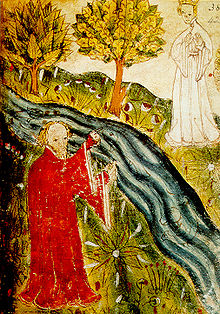John Massey (poet)

There are many identities that John Massey could have possessed in his lifetime. However, many have come across evidence from poems such as the Pearl and Sir Gawain and the Green Knight, that John Massey may have been the author. Although research has suggested various identities, the evidence is still disputable.
Theory of the authorship[]
The Gawain-poet is speculated to have written Sir Gawain and the Green Knight, Pearl, St. Erkenwald, and Patience. The first hint pointing to Massey being the Gawain-poet is in the Margins of St. Erkenwald. In the margins, there are multiple references to the booth family of Dunham-Massey, more specifically a ‘Thomas Masse’. The spelling of the name was not standardized at this point, and many variations were used. This is theorized by C.J Peterson.[1]
Anagrams in Pearl[]
Though no one is sure that John Massey was the author of Pearl and Sir Gawain and the Green Knight, scholars contend that Massey was the author and used hidden messages to credit himself.
One example of this can be found by looking at repetitions in the stanzas of the poem, Pearl.
“Since there are twenty sections in Pearl joined by linking words, we should expect 20 link-words. But this is not the case. There are only 18: more is used twice, in sections 3 and 10; and ryჳt, the last word of the section 12, has no link with section 13. Through this anomaly, attention is called to 12, the number of the broken-link stanza-group, and to 18, the number of lunk-words joining the stanza-groups together.”[2]
John Of Lancaster[]
Clifford Peterson has argued that John Massey may have been a member of the household of John of Lancaster, son of King Henry IV. If John Massey is the author of the Pearl, this means he would have had to be alive in the late end of the fourteenth century. John Massey of Cotton, a retainer in the house of Lancaster, may be the same J. Massey whose anagrams have been found in the Pearl and St. Erkenwald.[3]
Relation to Hoccleve and his Epistle[]
Massey is also suspected to have relations to Thomas Hoccleve, even possibly being mentioned in his epistle within the lines
"For rethorik hath his fro me the keye
Of his tresor, nat deyneth hir nobleye
Dele with noon so ignorant as me."
The poem goes on to mention more about Massey and his poetry and skill but nothing about his life outside of it. While connected to Massey, the poem never outright mentions a name, only saying that the person being written about has extreme talent in poetry and its devices. This also brings up the possibility of Massey being Mr. Turville-Petre’s William Massey; whatever the case may be, Massey was mentioned (be it outright our otherwise) in the poem. The mention having nothing to do with class or rank, just the incredible ability of the poet himself.[4]
References[]
- ^ C. J. Peterson. “Pearl and St. Erkenwald: Some Evidence for Authorship.” The Review of English Studies, vol. 25, no. 97, 1974, pp. 49–53. JSTOR, www.jstor.org/stable/514205.
- ^ The Review of English Studies, Vol. 22, No. 87 (Aug., 1971), pp. 295-302 Nolan, Barbara, and David Farley-Hills. “The Authorship of Pearl: Two Notes.” The Review of English Studies, vol. 22, Aug. 1971. JSTOR, https://www.jstor.org/stable/512383.
- ^ Clifford J. Peterson. “The Pearl-Poet and John Massey of Cotton, Cheshire.” The Review of English Studies, vol. 25, no. 99, 1974, pp. 257–266. JSTOR, www.jstor.org/stable/514012.
- ^ Peterson, Clifford, and Edward Wilson. “Hoccleve, the Old Hall Manuscript, Cotton Nero A.x., and the Pearl-Poet.” The Review of English Studies, vol. 28, no. 109, 1977, pp. 49–56. JSTOR, www.jstor.org/stable/514938.
- Sources
- Bowers, John M. (2001), The Politics of Pearl: Court Poetry in the Age of Richard II, Boydell & Brewer, pp. 10–11, ISBN 9780859915991
- "'Iste Liber Constat Johanni Mascy': Dublin, Trinity College MS 155", Middle English Poetry, Boydell & Brewer, pp. 91–101, 2001, ISBN 9781903153093
- British poets